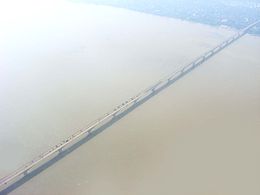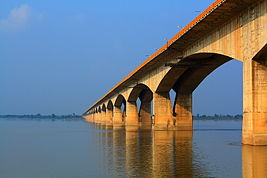- Mahatma Gandhi Setu
-
Mahatma Gandhi Setu 
A view of Mahatma Gandhi SetuOfficial name Mahatma Gandhi Setu Carries 4 lanes of roadway and pedestrian pathways each side Crosses Ganges River Locale Patna, Bihar, India Maintained by Bihar government Designer Gammon India Limited Design Girder bridge Material Concrete & steel Total length 5575 meter Width 25 meter Number of spans 48 Piers in water 40 Clearance below 265 Construction begin 1979 Construction end 1982 Opened May 1982 Toll Yes Closed No Coordinates 25°37′19.0″N 85°12′25.7″E / 25.62194°N 85.207139°ECoordinates: 25°37′19.0″N 85°12′25.7″E / 25.62194°N 85.207139°E Mahatma Gandhi Setu (Hindi: महात्मा गाँधी सेतु), is a bridge over the river Ganges connecting Patna in the south to Hajipur in the north of Bihar. It was the longest river bridge in India at the time of its construction. It was inaugurated in May 1982 by the then Prime Minister, Mrs Indira Gandhi.
Its length is 5,575 metres (18,291 ft)[1] which makes it was one of the longest bridges in the world.[2] There are 48 pilers to this bridge.
Contents
Architecture
This bridge was built by Gammon India Limited . It consists 46 spans of 121 metres (397 ft) each and 2 spans of 63 metres (207 ft) at each end. The deck provides for a 7.5 metres (25 ft) wide two lane roadway for IRC class 70 R loading with footpaths on either side.[3] The cantilever segmental construction method is adopted to construct this mega bridge. 650 million or 65 crore (at 1972 prices of India) rupees were spent on constructing this bridge.
Gallery
See also
- List of longest bridges in the world
- List of longest bridges above water in India
Notes
- Popularly known as Ganga Setu, It is the longest single river bridge in the world.[4]
- The Indian postal department issued a commemorative postage stamp on Landmark Bridges Of India: Mahatma Gandhi Setu of denomination 0500 Paise on 17 August 2007.[5]
- Currently this is part of National Highway 19.
- Before the bridge was constructed, people who wanted to go to north of Bihar, had to cross the river using boats or small ships or steamers or take a longer rail route.
References
- ^ Gammon India Limited Archived 12 February 2011 at WebCite
- ^ The Hindu : Karnataka / Bijapur News : Korthi-Kolhar bridge inaugurated Archived 12 February 2011 at WebCite
- ^ Gammon India Ltd. - Builders to the nation Archived 12 February 2011 at WebCite
- ^ The Hindu : Young World : Landmark bridges Archived 12 February 2011 at WebCite
- ^ Welcome to the Indiapost Web Site Archived 12 February 2011 at WebCite
http://album.gagan.mazed.googlepages.com/jamunabridge.jpg
http://www.ghumakkar.com/wp-content/uploads/2008/06/dscn0583.jpg
http://www.worldofstock.com/slides/TAN2136.jpg
Hydrology of Bihar Rivers North BiharBagmati • Burhi Gandak • Gandaki • Ganges • Kamala • Kankai • Kosi or Sapta Koshi • Lakhandei • Mahananda • Mechi • Ratua KholaSouth BiharWaterfalls Dams, barrages Indrapuri BarrageBridges Ganga Rail-Road Bridge • Koilwar Bridge • Mahatma Gandhi Setu • Munger Ganga Bridge • Jawahar Setu • Nehru Setu • Rajendra Setu • Vikramshila SetuRelated topics Floods in BiharHydrology of surrounding areas Uttar Pradesh • Nepal • Bengal • JharkhandTirhut division topics General Districts Community development blocks Rivers Transport Lok Sabha constituencies Hajipur • Muzaffarpur • Paschim Champaran • Purvi Champaran • Sheohar • Sitamarhi • Vaishali • Valmiki NagarFormer Lok Sabha constituencies Vidhan Sabha constituencies West Champaran Valmiki Nagar • Ramnagar • Narkatiaganj • Bagaha • Lauriya • Nautan • Chanpatia • Bettiah • Sikta East Champaran Raxaul • Sugauli • Narkatiya • Harsidhi • Govindganj • Kesaria • Kalyanpur • Pipra • Madhuban • Motihari • Chiraia • Dhaka Sheohar Sheohar Sitamarhi Riga • Bathnala • Parihar • Sursand • Bajpatti • Sitamarhi • Runnisaidpur • Belsand Muzaffarpur Gaighat • Aurai • Minapur • Bochahan • Sakra • Kurhani • Muzaffarpur • Kanti • Baruraj • Paroo • Sahebganj Vaishali Hajipur • Lalganj • Vaishali • Mahua • Raja Pakar • Raghopur • Mahnar • PatepurFormer Vidhan Sabha constituencies See also Cities and towns in Tirhut Division • Villages in West Champaran district • Villages in East Champaran district • Villages in Sitamarhi district • Villages in Muzaffarpur district • Villages in Vaishali district • People from Sitamarhi district • Bihar topicsOther Divisions Bhagalpur • Darbhanga • Kosi • Magadh • Munger • Patna • Purnia • SaranPatna division topics General Azimabad • Battle of Buxar • Kaimur Range • Nalanda • Pataliputra • Takht Sri Patna Sahib • Tourism in PatnaDistricts Rivers Dams, barrages Indrapuri BarrageTransport Lok Sabha constituencies See also Other Divisions Bhagalpur • Darbhanga • Kosi • Magadh • Munger • Purnia • Saran • Tirhut
This article about transport in India is a stub. You can help Wikipedia by expanding it.


